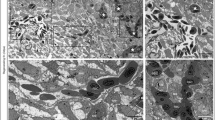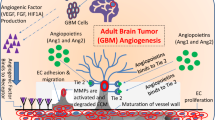Abstract
Background
Infantile hemangioma (IH) is the most common benign tumor of infancy, yet its pathogenesis is poorly understood. Notch family members are known to play a role in vascular development during embryogenesis and postnatal tumor angiogenesis, yet the role of Notch signaling in the pathogenesis of IH has not been investigated. This study aims to survey Notch expression in IH.
Materials and methods
RNA from resected hemangioma tissue and hemangioma-derived stem cells (HemSCs) and endothelial cells (HemECs) was used for gene expression analyses by real-time PCR. Results were confirmed with immunofluorescence for protein expression in tissue.
Results
Real-time PCR showed that Notch family gene expression in IH is distinct from placenta and skin. Notch3 is expressed in HemSCs, but not in HemECs, indicating Notch3 is downregulated as HemSCs differentiate into HemECs. Moreover, expression of endothelial-associated Notch proteins, Notch1, Notch4, and Jagged-1 are increased in involuting hemangiomas and HemECs, suggesting that as hemangioma progresses toward involution, it acquires more differentiated endothelium. A subset of cells stained double positive for Notch3 and CD31, pointing to a potential intermediate between the HemSC cellular differentiation into HemEC.
Conclusion
HemSCs have distinct Notch expression patterns from differentiated HemECs and from normal human endothelial cells. Notch3 is expressed in HemSCs, while Notch1, Notch4, and Jagged-1 have higher expression levels in HemECs. Notch3 was localized to the interstitial cells outside of the nascent vascular channels in proliferating IH tissue sections, but became more apparent in the perivascular cells in involuting IH. In summary, the pattern of Notch gene expression mirrors the progression from immature cells to endothelial-lined vascular channels (i.e., endothelial differentiation) that characterizes the growth and involution of IH.






Similar content being viewed by others
References
Frieden IJ, Haggstrom AN, Drolet BA, Mancini AJ, Friedlander SF, Boon L, Chamlin SL, Baselga E, Garzon MC, Nopper AJ, Siegel DH, Mathes EW, Goddard DS, Bischoff J, North PE, Esterly NB (2005) Infantile hemangiomas: current knowledge, future directions. Proceedings of a research workshop on infantile hemangiomas, April 7–9, Bethesda, Maryland, USA. Pediatr Dermatol 22:383–406
Mulliken JB, Fishman SJ, Burrows PE (2000) Vascular anomalies. Curr Probl Surg 37:517–584
Mulliken JB, Glowacki J (1982) Hemangiomas and vascular malformations in infants and children: a classification based on endothelial characteristics. Plast Reconstr Surg 69:412–422
North PE, Waner M, Mizeracki A, Mihm MC Jr (2000) GLUT1: a newly discovered immunohistochemical marker for juvenile hemangiomas. Hum Pathol 31:11–22
North PE, Waner M, Brodsky MC (2002) Are infantile hemangiomas of placental origin? Ophthalmology 109:633–634
Barnes CM, Christison-Lagay EA, Folkman J (2007) The placenta theory and the origin of infantile hemangioma. Lymphat Res Biol 5:245–255
Barnes CM, Huang S, Kaipainen A, Sanoudou D, Chen EJ, Eichler GS, Guo Y, Yu Y, Ingber DE, Mulliken JB, Beggs AH, Folkman J, Fishman SJ (2005) Evidence by molecular profiling for a placental origin of infantile hemangioma. Proc Natl Acad Sci USA 102:19097–19102
Kraling BM, Razon MJ, Boon LM, Zurakowski D, Seachord C, Darveau RP, Mulliken JB, Corless CL, Bischoff J (1996) E-selectin is present in proliferating endothelial cells in human hemangiomas. Am J Pathol 148:1181–1191
Takahashi K, Mulliken JB, Kozakewich HP, Rogers RA, Folkman J, Ezekowitz RA (1994) Cellular markers that distinguish the phases of hemangioma during infancy and childhood. J Clin Invest 93:2357–2364
Ritter MR, Moreno SK, Dorrell MI, Rubens J, Ney J, Friedlander DF, Bergman J, Cunningham BB, Eichenfield L, Reinisch J, Cohen S, Veccione T, Holmes R, Friedlander SF, Friedlander M (2003) Identifying potential regulators of infantile hemangioma progression through large-scale expression analysis: a possible role for the immune system and indoleamine 2, 3 dioxygenase (IDO) during involution. Lymphat Res Biol 1:291–299
Ritter MR, Dorrell MI, Edmonds J, Friedlander SF, Friedlander M (2002) Insulin-like growth factor 2 and potential regulators of hemangioma growth and involution identified by large-scale expression analysis. Proc Natl Acad Sci USA 99:7455–7460
Calicchio ML, Collins T, Kozakewich HP (2009) Identification of signaling systems in proliferating and involuting phase infantile hemangiomas by genome-wide transcriptional profiling. Am J Pathol 174:1638–1649
Bischoff J (2002) Monoclonal expansion of endothelial cells in hemangioma: an intrinsic defect with extrinsic consequences? Trends Cardiovasc Med 12:220–224
Boye E, Yu Y, Paranya G, Mulliken JB, Olsen BR, Bischoff J (2001) Clonality and altered behavior of endothelial cells from hemangiomas. J Clin Invest 107:745–752
Walter JW, North PE, Waner M, Mizeracki A, Blei F, Walker JW, Reinisch JF, Marchuk DA (2002) Somatic mutation of vascular endothelial growth factor receptors in juvenile hemangioma. Genes Chromosomes Cancer 33:295–303
Yu Y, Varughese J, Brown LF, Mulliken JB, Bischoff J (2001) Increased Tie2 expression, enhanced response to angiopoietin-1, and dysregulated angiopoietin-2 expression in hemangioma-derived endothelial cells. Am J Pathol 159:2271–2280
Jinnin M, Medici D, Park L, Limaye N, Liu Y, Boscolo E, Bischoff J, Vikkula M, Boye E, Olsen BR (2008) Suppressed NFAT-dependent VEGFR1 expression and constitutive VEGFR2 signaling in infantile hemangioma. Nat Med 14:1236–1246
Yu Y, Flint AF, Mulliken JB, Wu JK, Bischoff J (2004) Endothelial progenitor cells in infantile hemangioma. Blood 103:1373–1375
Kleinman ME, Blei F, Gurtner GC (2005) Circulating endothelial progenitor cells and vascular anomalies. Lymphat Res Biol 3:234–239
Khan ZA, Melero-Martin JM, Wu X, Paruchuri S, Boscolo E, Mulliken JB, Bischoff J (2006) Endothelial progenitor cells from infantile hemangioma and umbilical cord blood display unique cellular responses to endostatin. Blood 108:915–921
Khan ZA, Boscolo E, Picard A, Psutka S, Melero-Martin JM, Bartch TC, Mulliken JB, Bischoff J (2008) Multipotential stem cells recapitulate human infantile hemangioma in immunodeficient mice. J Clin Invest 118(7):2592–2599
Shawber CJ, Das I, Francisco E, Kitajewski J (2003) Notch signaling in primary endothelial cells. Ann NY Acad Sci 995:162–170
Shawber CJ, Kitajewski J (2004) Notch function in the vasculature: insights from zebrafish, mouse and man. Bioessays 26:225–234
Zhang G, Zhou J, Fan Q, Zheng Z, Zhang F, Liu X, Hu S (2008) Arterial-venous endothelial cell fate is related to vascular endothelial growth factor and Notch status during human bone mesenchymal stem cell differentiation. FEBS Lett 582:2957–2964
Patel NS, Li JL, Generali D, Poulsom R, Cranston DW, Harris AL (2005) Up-regulation of delta-like 4 ligand in human tumor vasculature and the role of basal expression in endothelial cell function. Cancer Res 65:8690–8697
Dufraine J, Funahashi Y, Kitajewski J (2008) Notch signaling regulates tumor angiogenesis by diverse mechanisms. Oncogene 27:5132–5137
Ridgway J, Zhang G, Wu Y, Stawicki S, Liang WC, Chanthery Y, Kowalski J, Watts RJ, Callahan C, Kasman I, Singh M, Chien M, Tan C, Hongo JA, de Sauvage F, Plowman G, Yan M (2006) Inhibition of Dll4 signalling inhibits tumour growth by deregulating angiogenesis. Nature 444:1083–1087
Funahashi Y, Hernandez SL, Das I, Ahn A, Huang J, Vorontchikhina M, Sharma A, Kanamaru E, Borisenko V, Desilva DM, Suzuki A, Wang X, Shawber CJ, Kandel JJ, Yamashiro DJ, Kitajewski J (2008) A notch1 ectodomain construct inhibits endothelial notch signaling, tumor growth, and angiogenesis. Cancer Res 68:4727–4735
Williams CK, Li JL, Murga M, Harris AL, Tosato G (2006) Up-regulation of the Notch ligand Delta-like 4 inhibits VEGF-induced endothelial cell function. Blood 107:931–939
Shawber CJ, Funahashi Y, Francisco E, Vorontchikhina M, Kitamura Y, Stowell SA, Borisenko V, Feirt N, Podgrabinska S, Shiraishi K, Chawengsaksophak K, Rossant J, Accili D, Skobe M, Kitajewski J (2007) Notch alters VEGF responsiveness in human and murine endothelial cells by direct regulation of VEGFR-3 expression. J Clin Invest 117:3369–3382
Wu JK, Kitajewski JK (2009) A potential role for Notch signaling in the pathogenesis and regulation of hemangiomas. J Craniofac Surg 20(1):698–702
Joutel A, Andreux F, Gaulis S, Domenga V, Cecillon M, Battail N, Piga N, Chapon F, Godfrain C, Tournier-Lasserve E (2000) The ectodomain of the Notch3 receptor accumulates within the cerebrovasculature of CADASIL patients. J Clin Invest 105:597–605
Doi H, Iso T, Shiba Y, Sato H, Yamazaki M, Oyama Y, Akiyama H, Tanaka T, Tomita T, Arai M, Takahashi M, Ikeda U, Kurabayashi M (2009) Notch signaling regulates the differentiation of bone marrow-derived cells into smooth muscle-like cells during arterial lesion formation. Biochem Biophys Res Commun 381:654–659
Benedito R, Roca C, Sorensen I, Adams S, Gossler A, Fruttiger M, Adams RH (2009) The notch ligands Dll4 and Jagged1 have opposing effects on angiogenesis. Cell 137:1124–1135
Liu H, Kennard S, Lilly B (2009) NOTCH3 expression is induced in mural cells through an autoregulatory loop that requires endothelial-expressed JAGGED1. Circ Res 104:466–475
Acknowledgments
The authors would like to thank Kristin Johnson for her help with preparation of the figures.
Author information
Authors and Affiliations
Corresponding author
Rights and permissions
About this article
Cite this article
Wu, J.K., Adepoju, O., De Silva, D. et al. A switch in Notch gene expression parallels stem cell to endothelial transition in infantile hemangioma. Angiogenesis 13, 15–23 (2010). https://doi.org/10.1007/s10456-009-9161-5
Received:
Accepted:
Published:
Issue Date:
DOI: https://doi.org/10.1007/s10456-009-9161-5




